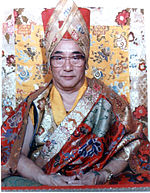Jigdal Dagchen Sakya, Date of Birth, Place of Birth, Date of Death
TweetJigdal Dagchen Sakya
Tibetan philosopher
 Date of Birth: 02-Nov-1929
Date of Birth: 02-Nov-1929
 Place of Birth: Tibet, China
Place of Birth: Tibet, China
Date of Death: 29-Apr-2016
Profession: lama
Zodiac Sign: Scorpio 
About Jigdal Dagchen Sakya
- Jigdal Dagchen Sakya Rinpoche (Tibetan: ??????????????????????????????????, ZYPY: Jigchä Dagqên Sa'gya Rinboqê; alt.
- Jigchai Dagqên Sa'gya Rinboqê; born November 2, 1929, died April 29, 2016) was a Tibetan Buddhist teacher educated in the Sakya sect.
- He was educated to be the head of the Sakya school of Tibetan Buddhism as well as the successor to the throne of Sakya, the third most important political position in Tibet in early times.
- Dagchen Rinpoche was in the twenty-sixth generation of the Sakya-Khön lineage descended from Khön Könchok Gyalpo and was regarded as an embodiment of Manjushri as well as the rebirth of a Sakya Lama from the Ngor sub-school, Ewam Luding Khenchen (The Great Abbot from the Luding family) Gyase Chökyi Nyima. Dagchen is a title meaning “Lineage Holder.” Among his followers he was known as Dagchen Rinpoche, or simply as Rinpoche (“Precious One”).
- His formal title of “His Holiness” indicates the high degree of esteem with which the Tibetan Buddhist community holds him. He immigrated in 1960 to the United States with his family, one of the first groups Tibetans-in-exile in North America.
- He is the first Head of the Sakya Order of Tibetan Buddhism to live in the United States.
- From the Sakya Monastery of Tibetan Buddhism in Seattle, Washington, and its precursor (which he co-founded in 1974), he taught and preserved Tibetan culture and religion.
- Because he was also a non-sectarian master within the Tibetan Buddhist tradition, he defined Sakya Monastery as a non-denominational and ecumenical center for teachings about Tibetan Buddhism.
- His work also included the foundation of Tibetan Buddhist communities overseas in India, Hong Kong, Taiwan, Nepal, Bhutan, and Southeast Asia, and teaching at Buddhist centers around the world.
Read more at Wikipedia

